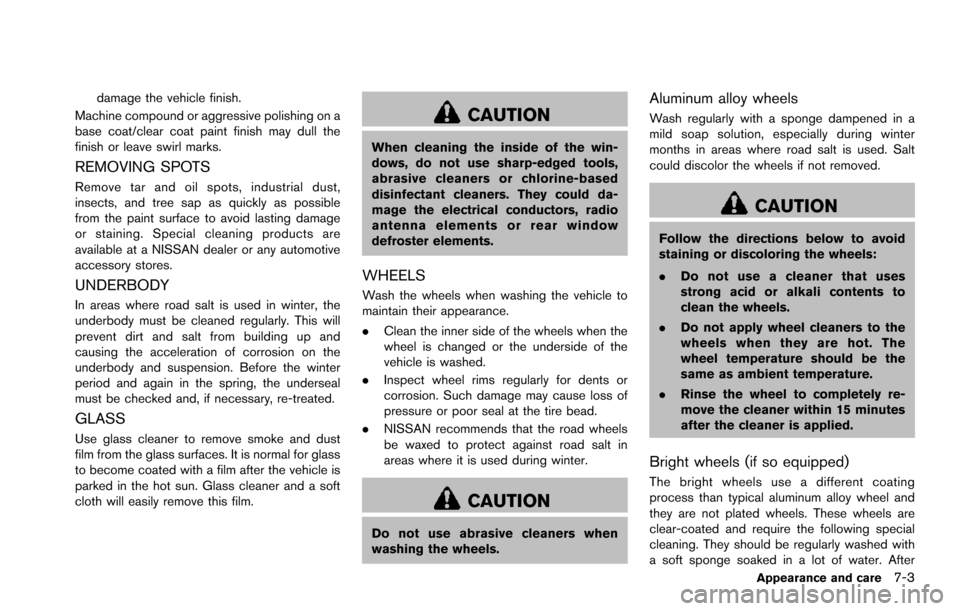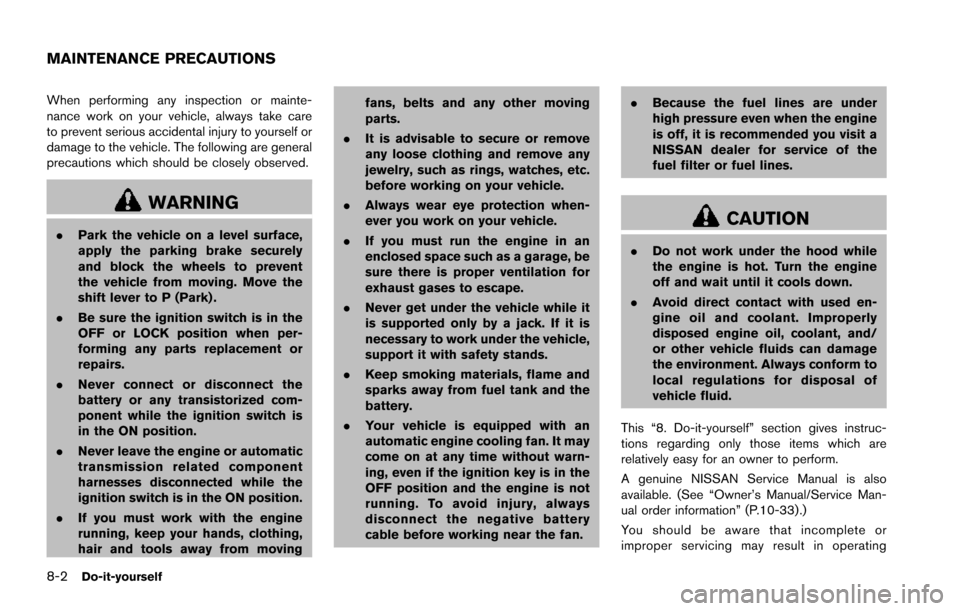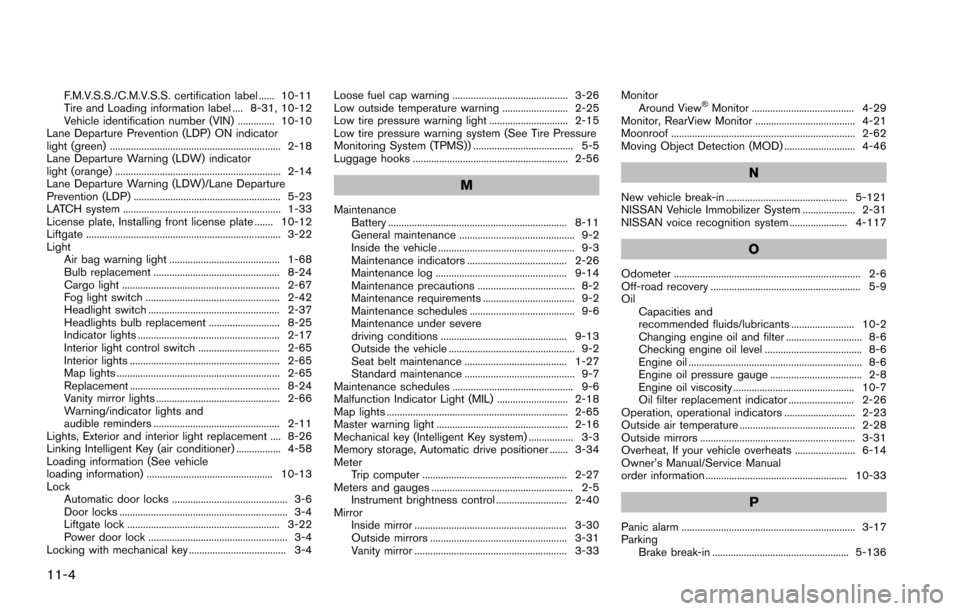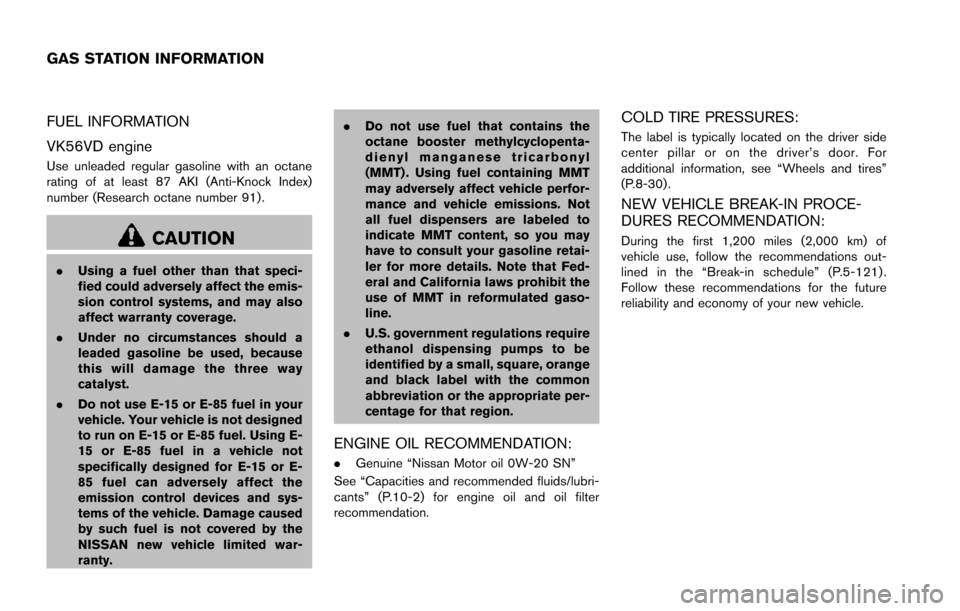2017 NISSAN ARMADA low oil pressure
[x] Cancel search: low oil pressurePage 510 of 614

damage the vehicle finish.
Machine compound or aggressive polishing on a
base coat/clear coat paint finish may dull the
finish or leave swirl marks.
REMOVING SPOTS
Remove tar and oil spots, industrial dust,
insects, and tree sap as quickly as possible
from the paint surface to avoid lasting damage
or staining. Special cleaning products are
available at a NISSAN dealer or any automotive
accessory stores.
UNDERBODY
In areas where road salt is used in winter, the
underbody must be cleaned regularly. This will
prevent dirt and salt from building up and
causing the acceleration of corrosion on the
underbody and suspension. Before the winter
period and again in the spring, the underseal
must be checked and, if necessary, re-treated.
GLASS
Use glass cleaner to remove smoke and dust
film from the glass surfaces. It is normal for glass
to become coated with a film after the vehicle is
parked in the hot sun. Glass cleaner and a soft
cloth will easily remove this film.
CAUTION
When cleaning the inside of the win-
dows, do not use sharp-edged tools,
abrasive cleaners or chlorine-based
disinfectant cleaners. They could da-
mage the electrical conductors, radio
antenna elements or rear window
defroster elements.
WHEELS
Wash the wheels when washing the vehicle to
maintain their appearance.
. Clean the inner side of the wheels when the
wheel is changed or the underside of the
vehicle is washed.
. Inspect wheel rims regularly for dents or
corrosion. Such damage may cause loss of
pressure or poor seal at the tire bead.
. NISSAN recommends that the road wheels
be waxed to protect against road salt in
areas where it is used during winter.
CAUTION
Do not use abrasive cleaners when
washing the wheels.
Aluminum alloy wheels
Wash regularly with a sponge dampened in a
mild soap solution, especially during winter
months in areas where road salt is used. Salt
could discolor the wheels if not removed.
CAUTION
Follow the directions below to avoid
staining or discoloring the wheels:
.Do not use a cleaner that uses
strong acid or alkali contents to
clean the wheels.
. Do not apply wheel cleaners to the
wheels when they are hot. The
wheel temperature should be the
same as ambient temperature.
. Rinse the wheel to completely re-
move the cleaner within 15 minutes
after the cleaner is applied.
Bright wheels (if so equipped)
The bright wheels use a different coating
process than typical aluminum alloy wheel and
they are not plated wheels. These wheels are
clear-coated and require the following special
cleaning. They should be regularly washed with
a soft sponge soaked in a lot of water. After
Appearance and care7-3
Page 517 of 614

8-2Do-it-yourself
When performing any inspection or mainte-
nance work on your vehicle, always take care
to prevent serious accidental injury to yourself or
damage to the vehicle. The following are general
precautions which should be closely observed.
WARNING
.Park the vehicle on a level surface,
apply the parking brake securely
and block the wheels to prevent
the vehicle from moving. Move the
shift lever to P (Park) .
. Be sure the ignition switch is in the
OFF or LOCK position when per-
forming any parts replacement or
repairs.
. Never connect or disconnect the
battery or any transistorized com-
ponent while the ignition switch is
in the ON position.
. Never leave the engine or automatic
transmission related component
harnesses disconnected while the
ignition switch is in the ON position.
. If you must work with the engine
running, keep your hands, clothing,
hair and tools away from moving fans, belts and any other moving
parts.
. It is advisable to secure or remove
any loose clothing and remove any
jewelry, such as rings, watches, etc.
before working on your vehicle.
. Always wear eye protection when-
ever you work on your vehicle.
. If you must run the engine in an
enclosed space such as a garage, be
sure there is proper ventilation for
exhaust gases to escape.
. Never get under the vehicle while it
is supported only by a jack. If it is
necessary to work under the vehicle,
support it with safety stands.
. Keep smoking materials, flame and
sparks away from fuel tank and the
battery.
. Your vehicle is equipped with an
automatic engine cooling fan. It may
come on at any time without warn-
ing, even if the ignition key is in the
OFF position and the engine is not
running. To avoid injury, always
disconnect the negative battery
cable before working near the fan. .
Because the fuel lines are under
high pressure even when the engine
is off, it is recommended you visit a
NISSAN dealer for service of the
fuel filter or fuel lines.CAUTION
.Do not work under the hood while
the engine is hot. Turn the engine
off and wait until it cools down.
. Avoid direct contact with used en-
gine oil and coolant. Improperly
disposed engine oil, coolant, and/
or other vehicle fluids can damage
the environment. Always conform to
local regulations for disposal of
vehicle fluid.
This “8. Do-it-yourself” section gives instruc-
tions regarding only those items which are
relatively easy for an owner to perform.
A genuine NISSAN Service Manual is also
available. (See “Owner’s Manual/Service Man-
ual order information” (P.10-33).)
You should be aware that incomplete or
improper servicing may result in operating
MAINTENANCE PRECAUTIONS
Page 609 of 614

11-4
F.M.V.S.S./C.M.V.S.S. certification label ...... 10-11
Tire and Loading information label .... 8-31, 10-12
Vehicle identification number (VIN) .............. 10-10
Lane Departure Prevention (LDP) ON indicator
light (green) ................................................................. 2-18
Lane Departure Warning (LDW) indicator
light (orange) ............................................................... 2-14
Lane Departure Warning (LDW)/Lane Departure
Prevention (LDP) ........................................................ 5-23
LATCH system ............................................................ 1-33
License plate, Installing front license plate ....... 10-12
Liftgate .......................................................................... 3-22
Light Air bag warning light .......................................... 1-68
Bulb replacement ................................................ 8-24
Cargo light ............................................................ 2-67
Fog light switch ................................................... 2-42
Headlight switch .................................................. 2-37
Headlights bulb replacement ........................... 8-25
Indicator lights ...................................................... 2-17
Interior light control switch ............................... 2-65
Interior lights ......................................................... 2-65
Map lights .............................................................. 2-65
Replacement ......................................................... 8-24
Vanity mirror lights ............................................... 2-66
Warning/indicator lights and
audible reminders ................................................ 2-11
Lights, Exterior and interior light replacement .... 8-26
Linking Intelligent Key (air conditioner) ................. 4-58
Loading information (See vehicle
loading information) ................................................ 10-13
Lock Automatic door locks ............................................ 3-6
Door locks ................................................................ 3-4
Liftgate lock .......................................................... 3-22
Power door lock ..................................................... 3-4
Locking with mechanical key ..................................... 3-4 Loose fuel cap warning ............................................ 3-26
Low outside temperature warning ......................... 2-25
Low tire pressure warning light .............................. 2-15
Low tire pressure warning system (See Tire Pressure
Monitoring System (TPMS)) ...................................... 5-5
Luggage hooks ........................................................... 2-56
M
Maintenance
Battery .................................................................... 8-11
General maintenance ............................................ 9-2
Inside the vehicle .................................................... 9-3
Maintenance indicators ...................................... 2-26
Maintenance log .................................................. 9-14
Maintenance precautions ..................................... 8-2
Maintenance requirements ................................... 9-2
Maintenance schedules ........................................ 9-6
Maintenance under severe
driving conditions ................................................ 9-13
Outside the vehicle ................................................ 9-2
Seat belt maintenance ....................................... 1-27
Standard maintenance .......................................... 9-7
Maintenance schedules .............................................. 9-6
Malfunction Indicator Light (MIL) ........................... 2-18
Map lights ..................................................................... 2-65
Master warning light .................................................. 2-16
Mechanical key (Intelligent Key system) ................. 3-3
Memory storage, Automatic drive positioner ....... 3-34
Meter Trip computer ....................................................... 2-27
Meters and gauges ...................................................... 2-5 Instrument brightness control ........................... 2-40
Mirror Inside mirror .......................................................... 3-30
Outside mirrors .................................................... 3-31
Vanity mirror .......................................................... 3-33 Monitor
Around View
�ŠMonitor ....................................... 4-29
Monitor, RearView Monitor ...................................... 4-21
Moonroof ...................................................................... 2-62
Moving Object Detection (MOD) ........................... 4-46
N
New vehicle break-in .............................................. 5-121
NISSAN Vehicle Immobilizer System .................... 2-31
NISSAN voice recognition system ...................... 4-117
O
Odometer ....................................................................... 2-6
Off-road recovery ......................................................... 5-9
Oil Capacities and
recommended fluids/lubricants ........................ 10-2
Changing engine oil and filter ............................. 8-6
Checking engine oil level ..................................... 8-6
Engine oil .................................................................. 8-6
Engine oil pressure gauge ................................... 2-8
Engine oil viscosity .............................................. 10-7
Oil filter replacement indicator ......................... 2-26
Operation, operational indicators ........................... 2-23
Outside air temperature ............................................ 2-28
Outside mirrors ........................................................... 3-31
Overheat, If your vehicle overheats ....................... 6-14
Owner’s Manual/Service Manual
order information ...................................................... 10-33
P
Panic alarm .................................................................. 3-17
Parking Brake break-in .................................................... 5-136
Page 613 of 614

FUEL INFORMATION
VK56VD engine
Use unleaded regular gasoline with an octane
rating of at least 87 AKI (Anti-Knock Index)
number (Research octane number 91) .
CAUTION
.Using a fuel other than that speci-
fied could adversely affect the emis-
sion control systems, and may also
affect warranty coverage.
. Under no circumstances should a
leaded gasoline be used, because
this will damage the three way
catalyst.
. Do not use E-15 or E-85 fuel in your
vehicle. Your vehicle is not designed
to run on E-15 or E-85 fuel. Using E-
15 or E-85 fuel in a vehicle not
specifically designed for E-15 or E-
85 fuel can adversely affect the
emission control devices and sys-
tems of the vehicle. Damage caused
by such fuel is not covered by the
NISSAN new vehicle limited war-
ranty. .
Do not use fuel that contains the
octane booster methylcyclopenta-
dienyl manganese tricarbonyl
(MMT) . Using fuel containing MMT
may adversely affect vehicle perfor-
mance and vehicle emissions. Not
all fuel dispensers are labeled to
indicate MMT content, so you may
have to consult your gasoline retai-
ler for more details. Note that Fed-
eral and California laws prohibit the
use of MMT in reformulated gaso-
line.
. U.S. government regulations require
ethanol dispensing pumps to be
identified by a small, square, orange
and black label with the common
abbreviation or the appropriate per-
centage for that region.
ENGINE OIL RECOMMENDATION:
.Genuine “Nissan Motor oil 0W-20 SN”
See “Capacities and recommended fluids/lubri-
cants” (P.10-2) for engine oil and oil filter
recommendation.
COLD TIRE PRESSURES:
The label is typically located on the driver side
center pillar or on the driver’s door. For
additional information, see “Wheels and tires”
(P.8-30) .
NEW VEHICLE BREAK-IN PROCE-
DURES RECOMMENDATION:
During the first 1,200 miles (2,000 km) of
vehicle use, follow the recommendations out-
lined in the “Break-in schedule” (P.5-121) .
Follow these recommendations for the future
reliability and economy of your new vehicle.
GAS STATION INFORMATION